SfMLearner
Unsupervised Learning of Depth and Ego-Motion from Video
Unsupervised Learning of Depth and Ego-Motion from Video
Tinghui Zhou, Matthew Brown, Noah Snavely, David G. Lowe
paper :
https://arxiv.org/abs/1704.07813
code :
https://github.com/tinghuiz/SfMLearner
핵심 요약 :
- monocular camera
- unsupervised learning by reconstruction loss (view synthesis)
- view synthesis (reconstruct target view from source view) by projection and warping
- projection할 때 아래에서 구한 depth와 pose 이용
- use 3 networks
- single-view depth CNN
- multi-view pose CNN
- explainability soft mask
Introduction
- SfM : Structure from Motion
end-to-end unsupervised learning from monocular video (only one camera lens) -
single-viewdepth estimation by per-pixel depth map -
multi-viewcamera motion (=ego-motion=pose) by6-DoF transformation matrices -
unsupervisedlearning : 직접적인 GT data가 아니라view synthesis (reconstruction term)를 supervision으로 씀
Related Work
- simultaneous estimation of structure and motion through deep learning
- end-to-end learning of transformation matrix without learning geometry explicitly
- learning of 3D single-view from registered 2D views
- unsupervised/self-supervised learning from video
Method
Approach
Assumption :
Scenes, which we are interested in, are mostly rigid, so changes across different frames are dominated by camera motion
View Synthesis as supervision
- View Synthesis : as supervision of depth and pose (추후 설명 예정)
- loss function (reconstruction term) :

\(p\) : index of target view’s pixel coordinates
\(s\) : index of source views
\(I_{t}(p)\) : target view
\(\hat I_{s}(p)\) : source view warped to target coordinate frame (= reconstructed target view) using predicted depth \(\hat D_{t}\) and \(4 \times 4\) camera transformation matrix \(\hat T_{t \rightarrow s}\) and source view \(I_{s}\)
- pipeline for depth and pose estimation :

Differentiable depth image-based rendering
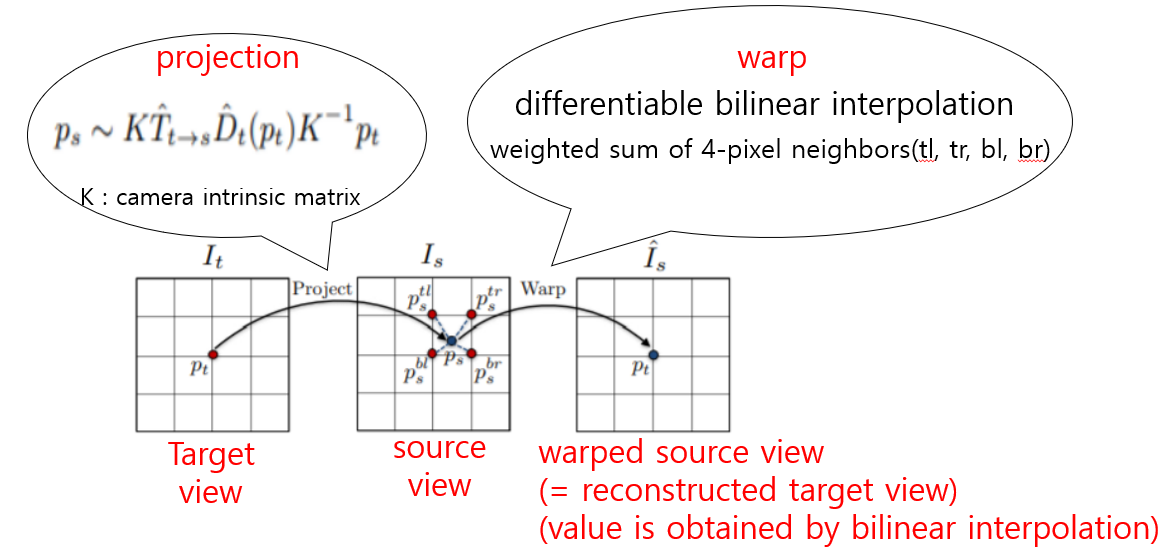
-
Depth CNN을 통해target view(single view)로부터depth prediction\(\hat D_{t}\) 얻기 -
Pose CNN을 통해target & source view(multi-view)로부터 \(4 \times 4\)camera transformation matrix\(\hat T_{t \rightarrow s}\) 얻기 - target view의 pixels를 source view coordinate으로
project하기
값이 아니라대응되는 위치를 구하기 위해
projection할 때 depth와 pose 이용- monocular camera이므로 두 카메라 사이의 상대적인 위치를 설명하는 \([R \vert t]\)는 고려 안함
- \(K^{-1}p_{t}\) : target view coordinate에서 2D 좌표 \(\rightarrow\) 3D 좌표
- \(\hat D_{t}(p_{t})K^{-1}p_{t}\) : target view의 3D depth map (= 2D depth \(\times\) 3D 좌표)
full 3D volumetric은 아니고, surface만 나타내는 3D target - \(\hat T_{t \rightarrow s} \hat D_{t}(p_{t})K^{-1}p_{t}\) : 3D depth map projected from target view to source view
- \(K \hat T_{t \rightarrow s} \hat D_{t}(p_{t})K^{-1}p_{t}\) : source view coordinate에서 3D 좌표 \(\rightarrow\) 2D 좌표
target view의 pixel 좌푯값을 source view의 좌푯값으로 project하는 데 중간에 depth map이 왜 필요한 거지???
- source view coordinate에서 differentiable bilinear
interpolation으로 value 얻은 뒤warp to target coordinate(=reconstructed target view)
source view의 pixel 값들을 이용해서 reconstruct target view
Modeling the model limitation
Assumption :
-
objects are static except camera (changes are dominated by camera motion)
물체들이 움직이지 않아야 Depth CNN과 Pose CNN이 같은 coordinate에 대해 project할 수 있다. -
there is no occlusion/disocclusion between target view and source view
target view와 source views 중 하나라도 물체가 가려져서 안보인다면 projection 정보가 없어 학습에 문제가 된다. -
surface is Lambertain so that photo-consistency error is meaningful
어떤 방향에서 보든 표면이 isotropic 똑같은 밝기로 보인다고 가정 \(\rightarrow\) photo-consistency에 차이가 있을 경우 이는 다른 surface를 의미함
Overcoming the gradient locality at loss term
-
To improve robustness, train additional network which predicts
explainability soft mask\(\hat E_{s}\) (=per-pixel weight), and add it to reconstruction loss term.
deep-learning model은 black-box이므로 explainablity는 중요한 요소 -
trivial sol. \(\hat E_{s} = 0\)을 방지하기 위해, add
regularizationterm that encourages nonzero prediction of \(\hat E_{s}\) -
직접 pixel intensity difference로 reconstruction loss를 얻으므로, GT depth & pose로 project하여 얻은 \(p_{s}\) 가 low-texture region or far region에 있을 경우 training 방해 (common issue in motion estimation)
\(\rightarrow\) 해결 1. use conv. encoder-decoder with small bottleneck
\(\rightarrow\) 해결 2. addmulti-scaleandsmoothness lossterm
(less sensitive to architecture choice, so 이 논문은 해결 2. 적용)


Network Architecture
- Network 1.
Single-view Depth CNN
input : target view
output : per-pixel depth map
DispNet encoder-decoder architecture
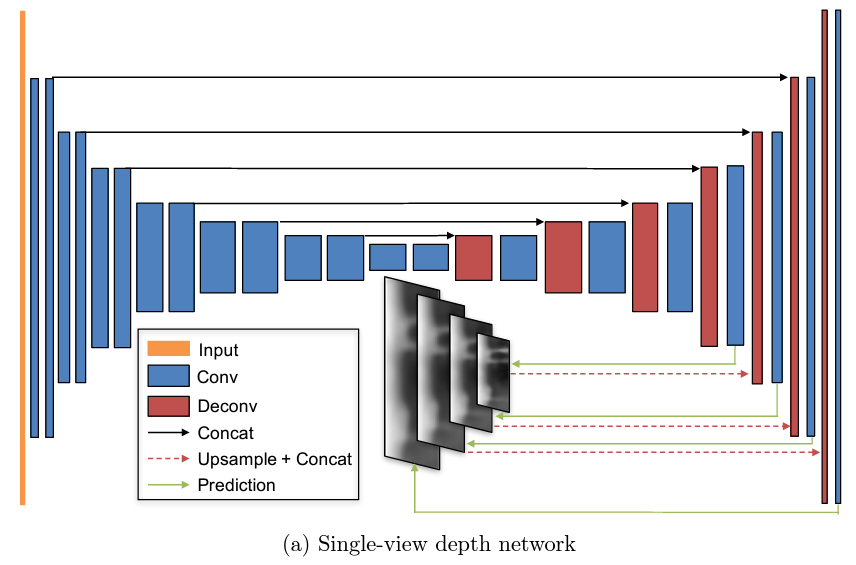
- Network 2.
Multi-view Pose CNN(아래 figure의 파란 부분)
input : target view concatenated with all source views
output : 6-DoF relative poses between target view and each source view
(Pose CNN estimates6 channels (3 Euler angles + 3D translation vector)for each source view, and then it is converted to \(4 \times 4\)transformation matrix)
어떻게 transformation matrix로 변환???
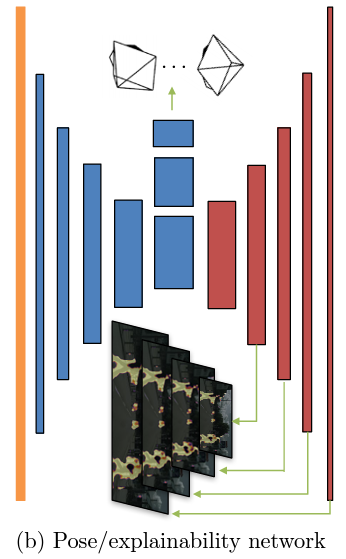

- Network 3.
Explainablity soft mask(=reconstruction weight per pixel) (위의 figure의 빨간 부분)
output : multi-scale explainability masks
(it estimates2 channelsfor each source view at each prediction layer)
weight per pixel인데 왜 2 channels are needed for explainability mask???
Experiments
Train : BN, Adam optimizer, monocular camera (one camera lens), resize input image
Test : arbitrary input image size
Single-view depth estimation
- train model on the split (exclude frames from test sequences and exclude static scene’s pixels with mean optical flow magnitude < 1)
- pre-trained on Cityscapes dataset / fine-tuned on KITTI dataset / test on Make3D dataset
- may improve if we also use left-right cycle consistency loss
- ablation study 결과, explainablity mask를 추가하고 fine-tuning하는 게 더 좋은 성능 도출
Multi-view pose estimation
- trained on KITTI odometry(change in position over time by motion sensor) dataset
- measurement :
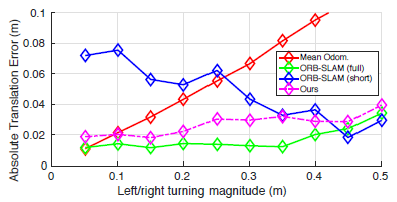
ATE : Absolute Trajectory Error
left/right turning magnitude : coordinate diff. in the side-direction between start and ending frame at test
Mean Odom. : mean of car motion for 5-frame snippets from GT odometry dataset
ORB-SLAM(full) : recover odometry using all frames for loop closure and re-localization
ORB-SLAM(short) : Ours에서처럼, use 5-frame snippets as input
\(\rightarrow\) 특히 small left/right turning magnitude (car is mostly driving forward) 상황에서 Ours가 ORB-SLAM(short)보다 성능 더 좋으므로 monocular SLAM system의 local estimation module을 Ours가 대체할 수 있을 것이라 예상
(SLAM 논문 아직 안 읽어봄. 읽어보자.)
Visualizing Explainability Prediction
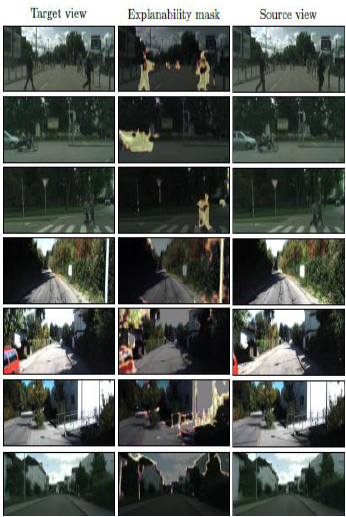
explainability = per-pixel weight (confidence 느낌) for reconstruction
row 1 ~ 3 : due to motion (dynamic objects are unexplainable)
row 4 ~ 5 : due to occlusion/visibility (disappeared objects are unexplainable)
row 6 ~ 7 : due to other factors (e.g. depth CNN has low confidence on thin structures)
Discussion
Contribution
- end-to-end
unsupervisedlearning frommonocularsequences
(기존에는 gt depth로 depth supervision 또는 calibrated stereo images로 pose supervision이었지만, 본 논문은view synthesis (reconstruction)을 supervision으로써서 unsupervised learning으로도 comparable performance 달성) - depth CNN recognizes common structural features of objects, and pose CNN uses image correspondence with estimating camera motion
Limitation
-
dynamic objects (X) / occlusion (X) / must be Lambertain surface / vast open scenes (X) / when objects are close to the front of camera (X) / thin structure (X)
\(\rightarrow\) 위의 한계들을 개선하고자 explainablity mask (= per-pixel reconstruction confidence 느낌) 도입했지만, it is implicit consideration -
assume that camera intrinsic K is given, so not generalized to the random videos with unknown camera types -
predict simplified 3D depth map of
surface(not full 3D volumetric representation)
중간중간에 있는 질문들은 아직 이해하지 못해서 남겨놓은 코멘트입니다.
추후에 다시 읽어보고 이해했다면 업데이트할 예정입니다.
혹시 알고 계신 분이 있으면 댓글로 남겨주시면 감사하겠습니다!